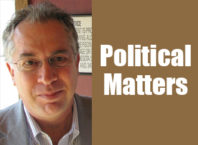By Mordecai Specktor
Louise Erdrich wins the Pulitzer
I’ll admit that Love Medicine is the only Louise Erdrich novel that I’ve read. Anyway, Mazel Tov! to Erdrich for winning the 2021 Pulitzer Prize for fiction, for her novel The Night Watchman. I bought a copy for my wife’s birthday last year, and I intend to read it soon.
The Pulitzer Prize judges called Erdrich’s most recent published work a “majestic, polyphonic novel about a community’s efforts to halt the proposed displacement and elimination of several Native American tribes in the 1950s, rendered with dexterity and imagination.”
Erdrich set her novel in 1953, and it is based on the efforts by her grandfather to resist a congressional effort to withdraw federal recognition from their tribe.
“I am an enrolled member, a citizen of the Turtle Mountain Band of Chippewa,” Erdrich told Dave Davies, a host of Fresh Air, the NPR interview program, last year. “It would be impossible for me to say that if termination had, indeed, won the day. So my father is German. I’m a very mixed person. And yet, being a citizen of a nation within our nation gives one a certain sense of – it changes your life. It means that I care deeply about my people, my mother’s people. And I grew up knowing who I was and accepting all parts of myself. And this is a part that I realized would not have existed had my grandfather not fought for it.”
You can listen to the entire Fresh Air interview, which was rebroadcast in April, at: bit.ly/erdrich-fresh-air.
In Saskatchewan
In my June column, I wrote about the discovery in May of a mass grave at the Kamloops Indian Residential School. It was widely reported that 215 children were buried on the grounds of the British Columbia school, one of the institutions established in Canada to forcibly assimilate Native children.
For those who want to learn more about the horrific torture and murder of students at the Kamloops school, I recommend the Intercepted podcast hosted by journalist and author Naomi Klein. She interviewed Doreen Manuel and her niece Kanahus Manuel. Doreen’s father, George Manual, was a survivor of the Kamloops school; Kanahus’ father, Arthur Manuel, was also a survivor.
It’s an extremely disturbing story. You can find the program and a complete transcription of the interview at: bit.ly/kamloops-intercepted.
And in late June, another graveyard – this one with as many as 751 unmarked graves – was discovered on the former site of the Marieval Indian Residential School in Saskatchewan.
The Marieval school operated from 1899 to 1996, overseen by the Roman Catholic Church, according to a report on Native News Online, which added that a majority of the 150 residential schools in Canada were in the province of Saskatchewan.
In a virtual press conference, Chief Cadmus Delorme, of the Cowessess First Nation in Saskatchewan, announced the grisly discovery of the unmarked graves at the Marieval location. The school, which operated from 1899 to 1966, was under the aegis of the Roman Catholic Church.
“Over the past years, the oral stories of our elders, of our survivors, and friends of our survivors have told the stories that knew these burials were here,” Delorme said. Students came to Marieval from several First Nations.
Delorme pointed out that the site is not a mass grave, but a regular graveyard until the Catholic Church possibly removed headstones in 1960.
“In 1960, there may have been marks on these graves. The Catholic Church representatives removed these headstones, and today they are unmarked graves,” commented Delorme.
After the news of the Kamloops mass grave, the Cowessess First Nation began surveying what is now its community gravesite with ground penetrating radar.
As per Native News Online: “Delorme said the radar detected 751 ‘hits’ of unmarked graves, though the machine has a 10 to 15 percent error rate, which confirms at least 600 gravesites with certainty. He also said the First Nation can’t yet confirm if there is more than one person buried under each detected ‘hit,’ though they will verify an exact number of burial sites in the coming weeks.”
Delorme also mentioned that oral histories say some of those graves might belong to adults: “Some may have went to the church and from our local towns, and they could have been buried here, as well.”
Bobby Cameron, Chief of the Federation of Sovereign Indigenous Nations, which represents the 74 First Nations in Saskatchewan, also participated in the virtual press conference.
“This was a crime against humanity,” Cameron said. “The only crime we ever committed as children was being born Indigenous.”





